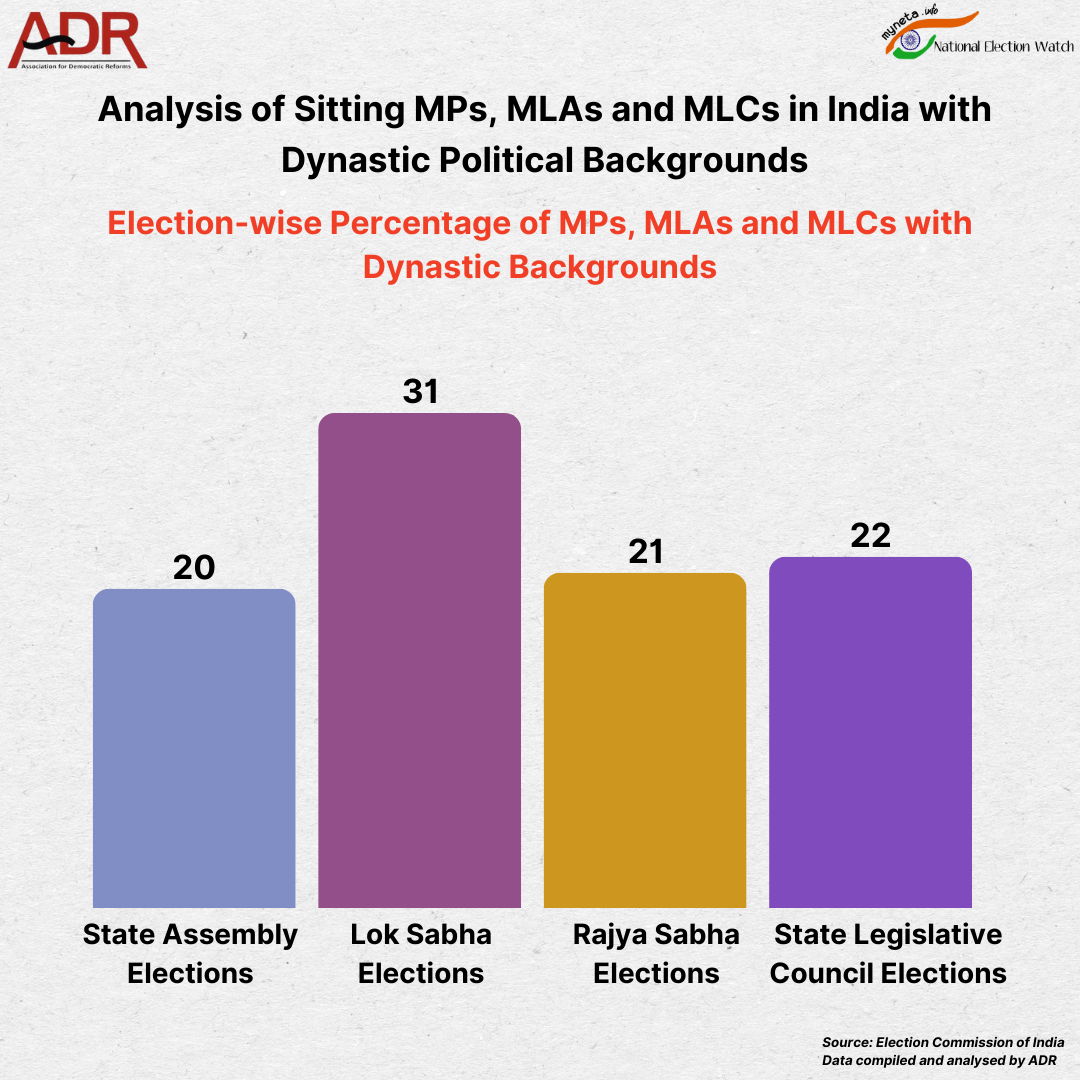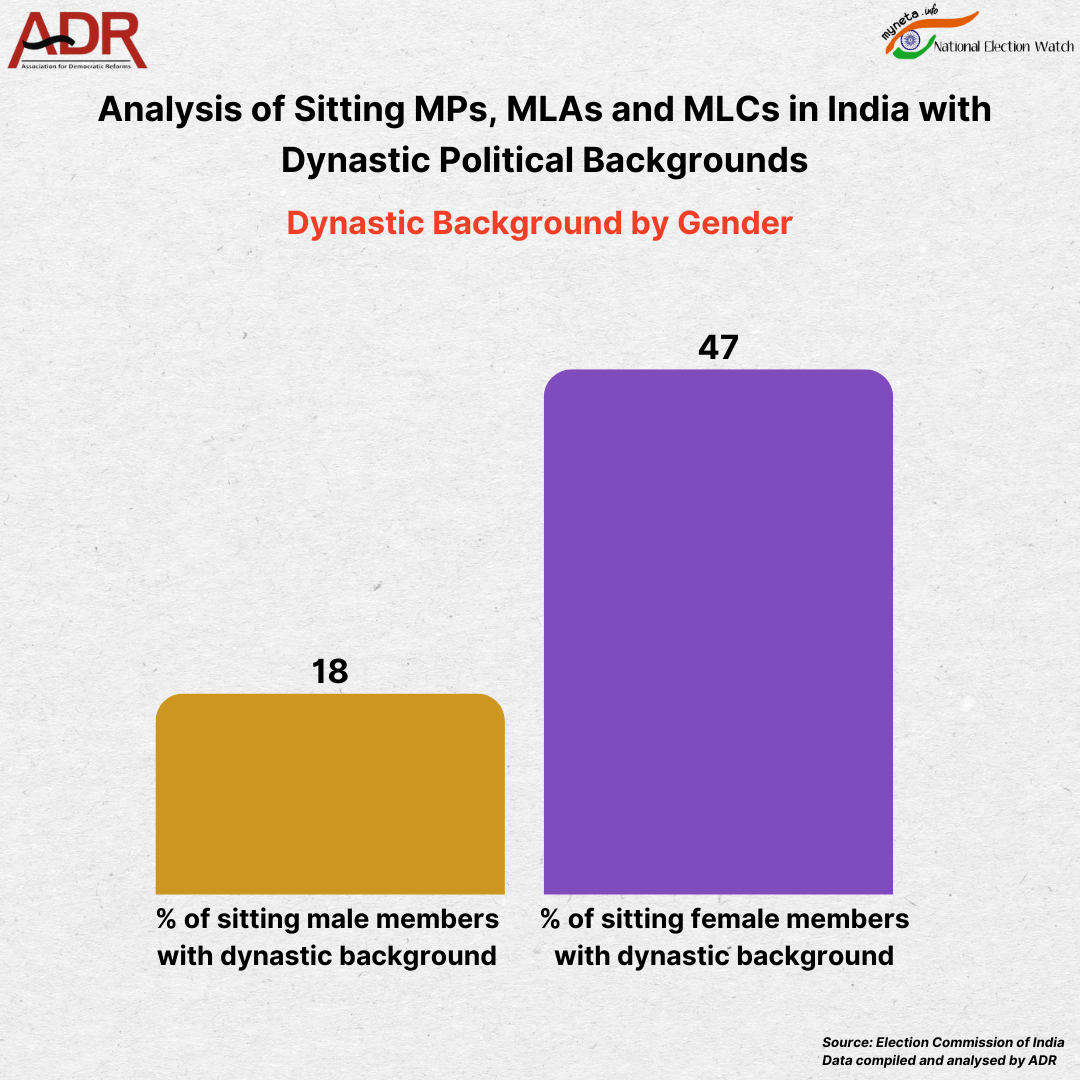Analysis of Sitting MPs, MLAs and MLCs in India with Dynastic Political Backgrounds
Association for Democratic Reforms (ADR) and National Election Watch (NEW) have done a comprehensive analysis of sitting Members of Parliament (MPs), Members of Legislative Assemblies (MLAs) and Member of Legislative Council (MLCs) in India who hail from political families. The data includes a total of 5203 sitting legislators across State Assemblies, the Lok Sabha, the Rajya Sabha, and State Legislative Councils. Among them, 1106 (21%) sitting members have dynastic backgrounds. Dynastic politics remains a cornerstone of Indian democracy, affecting about 1 in 5 sitting members.
Key Findings
Out of the 5203 sitting MPs, MLAs and MLCs analysed, 1106 (21%) sitting MPs, MLAs and MLCs have dynastic backgrounds. Notably, dynastic representation is highest in the Lok Sabha at 31%, and lowest in State Assemblies at 20%. These figures indicate that a significant share of current elected representatives belong to established political families.

National Parties: Among the national parties, 3,214 sitting MPs, MLAs and MLCs have been analyzed and 656 (20%) having dynastic backgrounds. INC has 32% of the sitting MPs, MLAs and MLCs from dynastic backgrounds followed by BJP with 17%, while smaller parties such as the CPI(M) show minimal dynastic influence, with only 8% of their sitting MPs, MLAs and MLCs from dynastic backgrounds.
State Parties: Among state parties, 1,808 sitting MPs, MLAs and MLCs have been analyzed and 406 (22%) are having dynastic backgrounds Parties like NCP-Sharadchandra Pawar (42%), JKNC (42%), YSRCP (38%), TDP (36%) and NCP (34%) exhibit strong dynastic tendencies, often rooted in regional family dynasties. Conversely, AITC (10%) and AIADMK (4%) have lower rates, possibly due to charismatic non-dynastic leadership. The Samajwadi Party, Janata Dal (United), Asom Gana Parishad and Rashtriya Janata Dal also exhibit high dynastic influence, with nearly 30% or more of their elected representatives being from political families.
Unrecognised Parties: These smaller entities have the highest dynastic rate as 21(24%) out of 87 sitting MPs, MLAs and MLCs analysed were found having dynastic backgrounds. Many have 100% dynastic members, likely because they are family-run or niche outfits with just 1-2 members. There are 9 parties having all MPs, MLAs and MLCs from dynastic backgrounds.
Independent: 23(24%) out of 94 sitting independent MPs, MLAs and MLCs analysed have dynastic political backgrounds. This reflects a moderate level of dynasticism, likely driven by politicians capitalizing on family networks while operating outside formal party structures.
Out of 4,664 sitting male MPs, MLAs and MLCs analyzed, 855 (18%) have a dynastic backgrounds. Among 539 sitting female MPs, MLAs and MLCs, 251 (47%) are from political families. Dynastic representation is more than twice as high among women as compared to men.

Observations
- Large states with strong party organizations (like Tamil Nadu, 15% and West Bengal, 9%) show lower dynasticism compared to smaller or mid-sized states (e.g., Jharkhand, 28%, Himachal Pradesh, 27%). This suggests that cadre-based or ideological parties (DMK, AIADMK, Left, TMC) may dilute dynastic entry more effectively than regional family-run outfits.
- Female dynastic prevalence (47%) being much higher than males (18%) indicates that women’s entry is systemically mediated by family connections. In states like Jharkhand (73% of women dynastic) and Maharashtra (69%), nearly all women in politics rely on family networks. This shows that while dynasticism opens doors for women, it simultaneously limits space for first-generation non-dynastic female politicians.
- Left-wing and newer reformist parties (CPI(M), AAP) have lowest dynasticism, aligning with their ideological positioning against elitism. By contrast, “social justice” or caste-based regional parties (SP, RJD, JD(U)) exhibit 30–40% dynasticism.
- Dynastic representation is higher in the Lok Sabha (31%) than in State Assemblies (20%). This suggests that national-level visibility and prestige are more tightly controlled by established political families, while state politics allows somewhat more entry to outsiders.
- 'The report’s numbers suggest that dynasticism is not merely about “inheritance of seats,” but a structural feature across geographies, parties, and genders. High rates among women and unrecognized parties imply dynastic politics is a mechanism of political entry and survival, not just legacy preservation.
- The report’s data shows that dynastic politics is not evenly spread — it thrives in smaller states/UTs, women’s representation, and national-level offices, while cadre-based ideological parties act as partial checks. It is as much about access to politics as it is about continuity of family power.
- The early signs of dynastic rule started appearing in national and regional politics in the 1970s in the realm of both party organisation and the representative institutions.
- Dynastic politics divides the society by creating a birth based ruling class. The prevalence of dynastic politics is also attributed to India’s strong family traditions that justify dynasts in the eyes of voters. In India, it’s widely thought to be natural and acceptable for a father or a mother who has any form of power to want to hand it over to a son or a daughter.
- The status, functioning and role played by political parties has also led to the persistent presence of dynasties in Indian politics. India’s political parties habitually give dynastic contenders a leg-up in the ticket allocation process without any fear of public audit or inspection. These instances repeatedly happen because of lack of internal democracy within parties, lack of criteria or qualification for ticket distribution, no law dealing with the regulation or functioning of parties, parties’ refusal to come under RTI law thereby leading to a complete lack of public accountability.
- Voter dissatisfaction, dynast’s relative wealth, dynastic incumbent, reserved constituency, key powerful position within party structure are some of the factors that significantly increase political party’s preferences for dynasts. In this context, dynastic politics not only impacts the right to equal political opportunity and electoral competitiveness but such a system of choosing potential leaders within families leads to an unfair and unequal representation within party as well as the electorate. This also impacts internal democracy within parties leading to weak organisation of political parties.
- Another reason behind the hegemony of political ¬dynasties over Indian political system lies in the way our political contestants’ function before, during and after the elections. Indian political system primarily functions on one major factor i.e ‘winnability’. The whole eco system of our elections relies on ‘money’ and ‘muscle power’ in one way or the other. Unprecedented, unequal and unregulated campaigning during elections has become a norm. This can only be achieved through candidates who have money-muscle nexus. Elections have become so expensive that they are beyond any ordinary citizen’s reach unless they have powerful patrons or the backing of a large party. Voters also make their choices depending on what they can expect from which party i.e someone who gets things done whether dynast, moneyed or muscle power. The political parties also prefer to practise patronage politics as a way to ensure loyalty and to meet voter demands rather than act as agents of structural change. The existing 10th schedule i.e the Anti Defection Law can also at times may punish an elected legislator who crosses the party line or loyalty.
- In cases with more than one claimant for the top post male siblings are often preferred for the leadership role.

